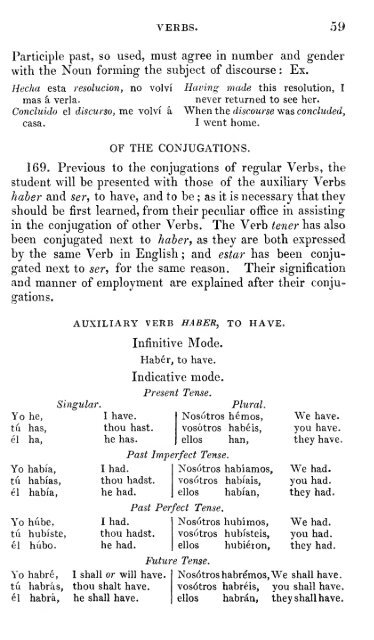A concise and simplified grammar of the Spanish language
A concise and simplified grammar of the Spanish language
A concise and simplified grammar of the Spanish language
You also want an ePaper? Increase the reach of your titles
YUMPU automatically turns print PDFs into web optimized ePapers that Google loves.
59<br />
Participle past, so used, must agree in number <strong>and</strong> gender<br />
with <strong>the</strong> Noun forming <strong>the</strong> subject <strong>of</strong> discourse : Ex.<br />
Hecha esta resolución, no volví Having made this resolution, I<br />
mas k verla.<br />
Concluido el discurso, me volví á<br />
never returned to see her.<br />
When <strong>the</strong> discourse was concluded,<br />
casa. I went home.<br />
OF THE CONJUGATIONS.<br />
169. Previous to <strong>the</strong> conjugations <strong>of</strong> regular Verbs, <strong>the</strong><br />
student will be presented with those <strong>of</strong> <strong>the</strong> auxiliary Verbs<br />
haber <strong>and</strong> ser, to have, <strong>and</strong> to be ; as it is necessary that <strong>the</strong>y<br />
should be first learned, from <strong>the</strong>ir peculiar <strong>of</strong>fice in assisting<br />
in <strong>the</strong> conjugation <strong>of</strong> o<strong>the</strong>r Verbs. The Verb tener has also<br />
been conjugated next to haber, as <strong>the</strong>y are both expressed<br />
by <strong>the</strong> same Verb in English ; <strong>and</strong> estar has been conjugated<br />
next to ser, for <strong>the</strong> same reason. Their signification<br />
<strong>and</strong> manner <strong>of</strong> employment are explained after <strong>the</strong>ir conju-<br />
gations.<br />
AUXILIARY VERB HABER, TO HAVE.<br />
Infinitive Mode.

















